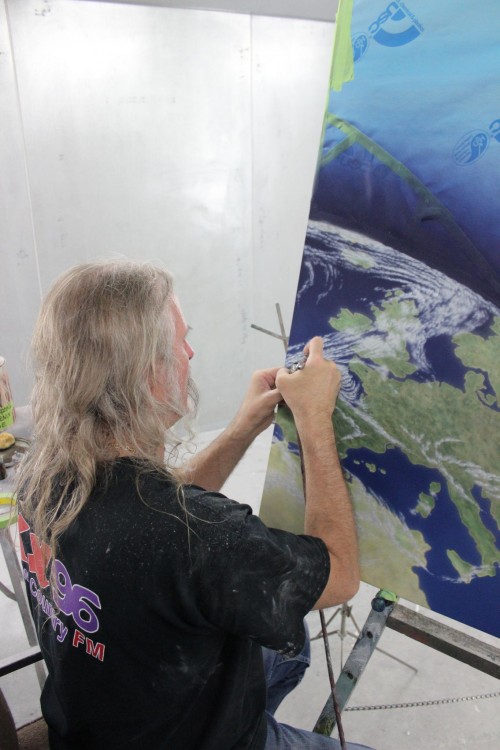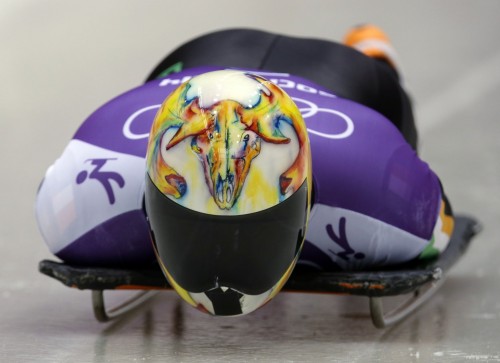Sign Shop Profile: Voodoo Air
by all | 12 August 2014 1:30 pm
 [1]
[1]Photos courtesy Voodoo Air
By Peter Saunders
As people around the world viewed the 2014 Winter Olympic Games broadcast from Sochi, Russia, many noticed the distinctive artwork on helmets worn by racers in the skeleton event. Since skeleton racers lie face down while riding a small sled along a frozen chute, the helmet is prominently displayed to the front, providing ample opportunity for creative expression.
One of the companies that have become well-known for painting these unique designs is Voodoo Air in Pickering, Ont. Its owner, Gerald McLaughlin, painted the helmets worn at the Sochi Games by Canada’s John Fairbairn and Mellisa Hollingsworth and Ireland’s Sean Greenwood. Fairbairn’s depicted an exposed brain, for example, because a German track announcer mispronounced his surname as ‘Fairbrain’ several years ago. Hollingsworth’s showed the skeleton of a horse because of her experience in rodeo events like barrel racing. And Greenwood’s helmet featured an elk because he’s originally from Canada.
They were among the highest-profile projects for McLaughlin, who picked up his first airbrush in 1978, founded Voodoo in 1985 and has created countless graphics, signs and dimensional pieces ever since.
A lifetime of art
Born in Oshawa, Ont., McLauglin always knew he would be an artist. As a child, he drew a mural in crayon that covered an entire wall of his bedroom, then went on to paint his skateboards.
 [2]
[2]Gerald McLaughlin picked up his first airbrush in 1978 and has been painting graphics ever since.
“In high school, one of my art classes took a trip to Oshawa’s Robert McLaughlin Gallery and I was intrigued by an airbrushed piece,” he says. “And when I was 17, I saw an article about an airbrush artist whose work was hanging in the Louvre in Paris. That was it. A friend and I drove all the way to Detroit, Mich., to buy an airbrush (even though we probably could have found one in Toronto), came back home and just started making art.”
He decided to attend Oshawa’s Durham College because it offered an airbrushing course, but the class was cancelled when the teacher retired that year. So, instead, McLaughlin hung out every day after his classes with a professional airbrush artist, Ed Grant, to hone his skills and learn more about the business.
“I stuck it out at college for one year just to please my parents, then went out on the road with a rock band,” he says. “I worked as their sound man and got to airbrush shirts on the side.”
Through the music-industry connections he made over the years, he also airbrushed guitars (including one for Iron Maiden), motorcycles’ gas tanks, cars and album covers. His work on vehicles allowed him to strike out on his own.
“Before I opened Voodoo, I would rent the corner of a garage, work in a body shop and exhibit at auto shows,” he says. “As my business got more legitimate, I was able to raise my prices and work on larger projects, including signs.”
With the advent of vinyl cutters and plotters, McLaughlin felt airbrushing was his “trump card,” as he could match other sign shops’ prices, but with more distinctive-looking results.
“I even did backlit airbrushed signs, which are very difficult because you’re painting everything in reverse,” he says. “Those were pretty lucrative.”
Added dimensions
In the late 1980s and early ‘90s, as sandblasted signs became more common, McLaughlin added three-dimensional (3-D) sculpting to Voodoo’s toolkit. Again, his music-industry connections led the way.
“I created backdrops for Canadian Music Week (CMW), singer Susan Aglukark’s concert tour and a heavy metal convention in Los Angeles, Calif.,” he says. “I also fabricated and painted a fire-rated fibreglass head based on a digitally altered photo for CMW’s promotional purposes. Using a 13-piece mould, I made seven of these heads and you can still see them show up at the yearly event.”
 [3]
[3]Recently, McLaughlin painted some of the helmets worn by racers in the skeleton event at the 2014 Winter Olympic Games, including an elk-inspired design for Ireland’s Sean Greenwood, who is originally from Canada. File photo
That project, especially, led to more sculpting work and bigger commissions from advertising agencies, including a ‘chickenmobile’ when the Popeye’s Chicken chain was expanding in Ontario, along with giant fruits mounted on the roofs of repurposed ambulances painted to resemble Minute Maid’s Five Alive juice boxes.
“One of the oranges fell off and bounced along the highway!” McLaughlin says. “That’s when I learned about liability and structural integrity.”
A smaller-format—but even bigger-scale—job came along when Molson asked McLaughlin to paint a hockey goalie mask for a contest. Voodoo ended up producing 90 of them and got its logo displayed on beer cases distributed throughout the U.S.
“That project got its own legs and really took off,” he says. “Molson had teams of guys going into bars wearing painted goalie pads and jerseys. After that, they kept coming back for more.”
For the 2010 Winter Olympic Games in Vancouver and Whistler, B.C., the brewer commissioned five giant airbrushed goalie masks for the Molson Canadian Hockey House. Voodoo worked with Plastiglas Industries in Ajax, Ont., to create the ‘elephant masks.’ One was signed by members of the gold-medal-winning Canadian men’s team before being auctioned off for charity.
In turn, Canadian Tire ordered some 400 more to serve as permanent merchandising displays in 235 of its stores across the country. Voodoo also managed to sell some to sports bars.
“Now some of the Canadian Tire stores have hired me to add special paint jobs,” says McLaughlin. “That’s been a nice extra.”
Worldwide exposure
Working with Plastiglas, meanwhile, has led Voodoo to build sculptures for ProSlide water parks. McLaughlin developed 4.6-m (15-ft) long sailfish and other sea creatures for the Water Cube in Beijing, China, a former Summer Olympic Games venue repurposed as a recreational facility for the public, while Plastiglas provided plastic tubes for the water slides.
“We’ve now done five parks for ProSlide,” says McLaughlin. “They help promote our work around the world.”
Fortunately, Voodoo is now based in a 502-m2 (5,400 sf) facility, with room to tackle such large-scale projects. The business has come a long way from the early ‘80s, when McLaughlin lived and painted in a 3 x 3-m (10 x 10-ft) room in Toronto.
“I even lived in a van for a while,” he says. “These days, I bring in subcontractors for the big jobs, including artisans, sculptors and woodworkers. I don’t have employees. People in this field seem to like me and want to work with me.”
- [Image]: http://www.signmedia.ca/wp-content/uploads/2015/08/DSC_0922.jpg
- [Image]: http://www.signmedia.ca/wp-content/uploads/2015/08/IMG_4554.jpg
- [Image]: http://www.signmedia.ca/wp-content/uploads/2015/08/greenwood.jpg
Source URL: https://www.signmedia.ca/shop-talk-sign-shop-profile-voodoo-air/